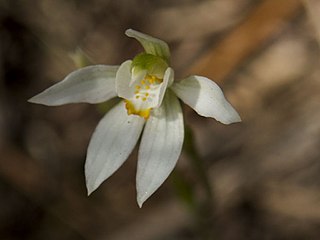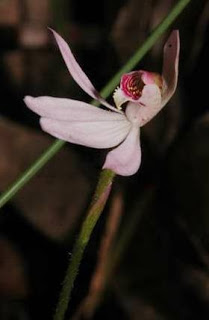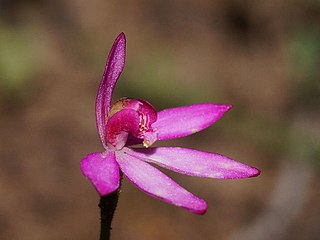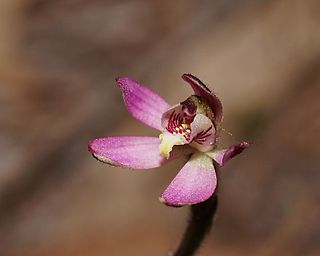
Caladenia, commonly known as spider orchids, is a genus of 350 species of plants in the orchid family, Orchidaceae. Spider orchids are terrestrial herbs with a single hairy leaf and a hairy stem. The labellum is fringed or toothed in most species and there are small projections called calli on the labellum. The flowers have adaptations to attract particular species of insects for pollination. The genus is divided into three groups on the basis of flower shape, broadly, spider orchids, zebra orchids and cowslip orchids, although other common names are often used. Although they occur in other countries, most are Australian and 136 species occur in Western Australia, making it the most species-rich orchid genus in that state.

Caladenia carnea, commonly known as pink fingers, is a plant in the orchid family Orchidaceae and is endemic to eastern and south-eastern Australia, including Tasmania. It has a single thin, green leaf and one to five white or pink flowers with red stripes and two rows of yellow-tipped "calli" on their labellum.

Caladenia fuscata, commonly known as dusky fingers, is a plant in the orchid family Orchidaceae and is endemic to eastern and south-eastern Australia, including Tasmania. It is a small ground orchid found in eucalyptus woodland and which flowers in September and October.

Caladenia aurantiaca, commonly known as orangetip fingers, is a plant in the orchid family Orchidaceae and is endemic to Victoria, although it is also found on one Bass Strait island. It is a slender ground orchid with a single hairy leaf and one or two short-lived, orange-tipped, white flowers on a thin, wiry spike.
Caladenia bartlettii is a plant in the orchid family Orchidaceae and is endemic to New Zealand. It is a ground orchid with a single narrow, hairy leaf and a thin wiry stem usually bearing one short-lived mauve to pink flower.
Caladenia bicalliata subsp. cleistogama, commonly known as the shy limestone spider orchid or sandhill spider orchid, is a plant in the orchid family Orchidaceae and is native to the south-west of Western Australia. It has a single erect, hairy leaf and one or two cream-coloured flowers which are smaller than those in subspecies bacalliata.
Caladenia campbellii, commonly known as thickstem fairy fingers or thick-stem caladenia, is a plant in the orchid family Orchidaceae and is endemic to Tasmania. It is a ground orchid with a single, sparsely hairy leaf and one or two flowers that are pinkish on the outside and cream-coloured on the inside. The flowers are self-pollinating and short-lived.

Caladenia catenata, commonly known as white caladenia, white fingers and lady's fingers, is a plant in the orchid family Orchidaceae and is endemic to New South Wales, Queensland and Victoria. It is a ground orchid with a single hairy leaf and one or two white, sometimes pink flowers on a thin, sparsely-hairy stem. It is similar to Caladenia carnea but lacks the red and white bars on the labellum of that species.

Caladenia curtisepala, commonly known as short-hooded fingers, is a plant in the orchid family Orchidaceae and is endemic to south-eastern Australia. It is a ground orchid with a single hairy leaf, and a single white to cream-coloured flower with a white labellum with red bands.
Caladenia flaccida, commonly known as the flaccid spider orchid, is a plant in the orchid family Orchidaceae and is endemic to eastern Australia. It is a ground orchid with a single hairy leaf and up to three cream-coloured, pinkish or red flowers with long, thread-like, glandular tips on the sepals and petals.

Caladenia fragrantissima, commonly known as the scented spider orchid, is a plant in the orchid family Orchidaceae and is endemic to Victoria and South Australia. It is a ground orchid with a single hairy leaf and up to three creamy-white to yellowish-green flowers. It is possible that it is conspecific with Caladenia orientalis.
Caladenia hastata, commonly known as Mellblom's spider orchid is a plant in the orchid family Orchidaceae and is endemic to Victoria. It is a ground orchid with a single hairy leaf and up to three white to cream-coloured flowers with red markings on the labellum.

Caladenia mentiens, commonly known as lesser fingers, is a species of orchid endemic to south-eastern Australia which grows singly, or in small, loose groups. It has a single, sparsely hairy, erect, linear leaf and a single whitish or pinkish coloured flower with a darker back and a cream-coloured labellum.
Caladenia nothofageti, commonly known as beech caladenia or white fingers, is a plant in the orchid family Orchidaceae and is endemic to New Zealand. It has a single, sparsely hairy, long, thin leaf and one or two white flowers with greenish-white backs, on a thin stalk.

Caladenia ornata, commonly known as ornate pink fingers is a species of orchid endemic to Victoria. It has a single leaf and one or two bright pink flowers with greenish-pink backs, and a dark pink labellum with dark red bars.

Caladenia pusilla, commonly known as tiny fingers, pygmy caladenia, tiny caladenia or pink fingers, is a plant in the orchid family Orchidaceae and is native to Australia and New Zealand. It is a ground orchid with a single erect, sparsely hairy leaf and a single pink flower with a brownish-pink back. The flowers are short-lived and self-pollinating.

Caladenia valida, commonly known as the robust spider orchid, is a plant in the orchid family Orchidaceae and is endemic to south-eastern continental Australia. It is a ground orchid with a single sparsely hairy leaf and up to three white to cream-coloured flowers which sometimes have red streaks. It is similar to Caladenia reticulata but is large and taller with more stiffly spreading lateral sepals and petals.
Caladenia gracillima, commonly known as pretty fingers, is a species of orchid endemic to eastern Australia. It has a single leaf and up to three bright pink flowers. The type specimen was collected at Yandina in southern Queensland but there are also records from southern New South Wales.
Caladenia pygmaea, commonly known as the pygmy finger orchid is a plant in the orchid family Orchidaceae and is endemic to South Australia. It is a ground orchid with a single erect, sparsely hairy leaf and a single pink flower with red stripes on the labellum. It was formerly known as a variety of Caladenia carnea.

Thelymitra carnea, commonly called the tiny sun orchid or pinkish sun orchid, is a species of orchid that is native to Australia and New Zealand. It has narrow, almost cylindrical leaves and up to four relatively small pale to deep pink flowers on a wiry, zig-zag stem.






















